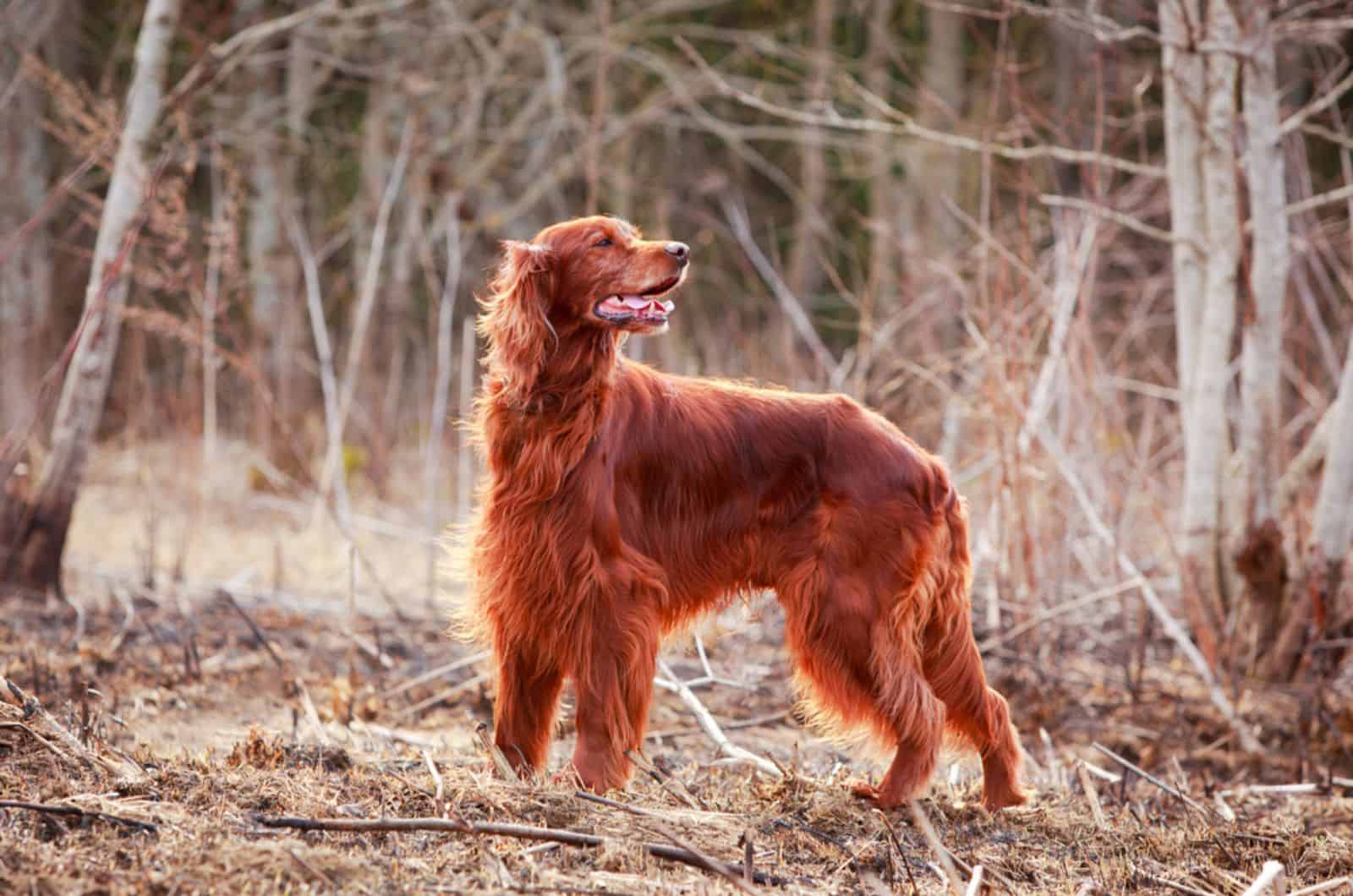If you have an Irish Setter puppy, you might be interested in learning more about the typical size, weight, and growth rate of these dogs.
To help you keep tabs on their growth, we’ve produced an Irish Setter growth chart that groups their expected weight by age.
Due to the beauty of their deep mahogany coats and their excitement as bird dogs, Irish Setters gained popularity quickly after being developed as gundogs in their native Ireland.
They have a lot of energy and are friendly, naughty, and curious. This outgoing family friend has the ability to excel in a variety of canine sports and activities.
Let’s begin discussing the Irish Setter growth chart.
Irish Setter Growth Chart
[table id=697 /]
[table id=698 /]
About The Irish Setter Breed Of Dog
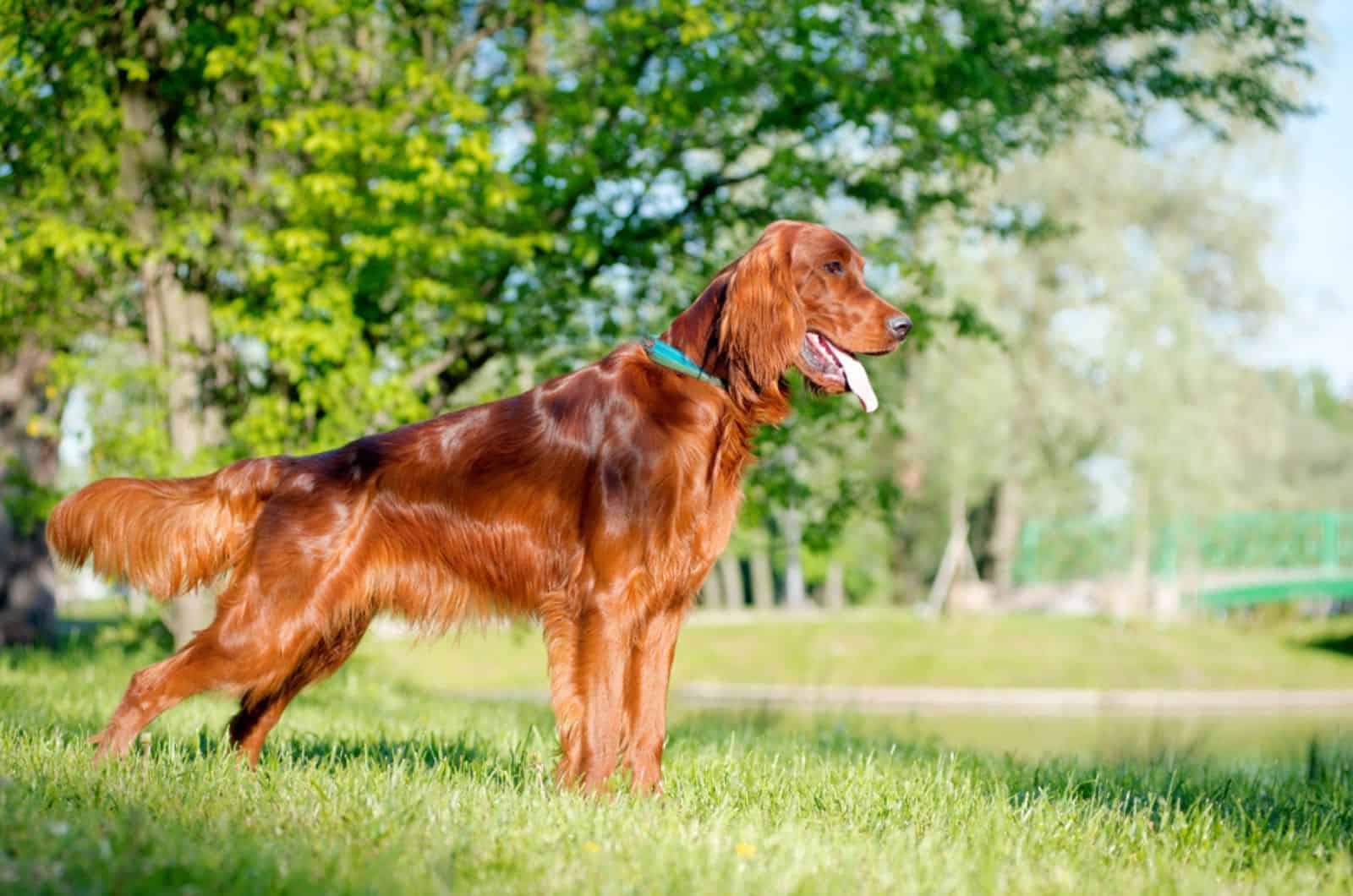
Irish Setters are friendly and outgoing dogs.
They make great watchdogs and will bark to alert you to any guests or trespassers. Irish Setters take a long time to grow, and they frequently keep their puppy-like eagerness for the entirety of their lives.
Numerous elements, including training, socialization, and genetics, have an impact on their temperament. Puppies with good dispositions are engaged and playful, approachable, and want to be cuddled.
Irish Setters need early socialization, or being exposed to a variety of people, sights, noises, and experiences when they’re young, just like every other breed of dog.
In order to guarantee that your Irish Setter puppy develops into a well-rounded adult dog, early socialization is key.
Regularly hosting guests, taking it to crowded parks, dog-friendly shops, and on leisurely strolls to meet the neighbors will all help it hone its social skills.
Irish Setter Nutrition
An Irish Setter should consume two or three cups of high-quality dry food every day, split between two mealtimes.
The amount of food your adult dog consumes is influenced by its size, age, build, metabolism, and degree of activity.
Like people, each dog is unique, thus they don’t all require the same amount of food. A very active dog will require more than a couch potato dog, which should almost go without saying.
The kind of dog food you purchase also matters; the better the food, the more effectively it will nourish your dog, and the less you will need to put into the bowl.
Try to find a kibble that is rich in omega fatty acids and protein, while being low in carbohydrates.
Related: 13 Worst Dog Food Brands On the Market
Irish Setter Puppy’s Stages Of Development
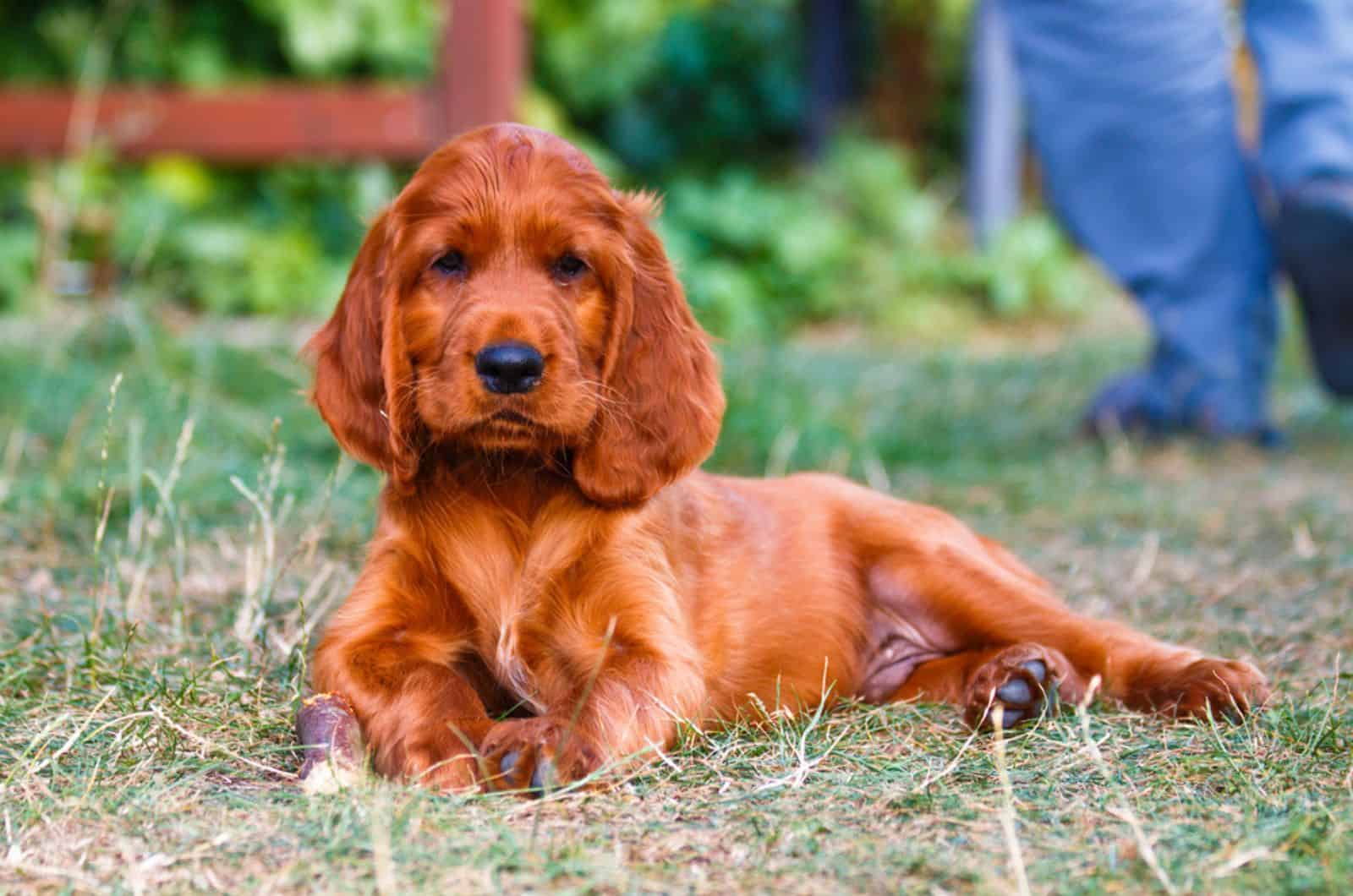
The primary physical and psychological changes that the Irish Setter puppy’s body goes through during its first twelve months of growth are broken down in the sections that follow, along with how it pertains to puppy weight.
Aside from giving you the raw numbers in the Irish Setter growth chart, we also wanted to provide a bit more insight into the actual processes that take place in your puppy’s body and mind during these key periods of its lifespan.
It’s an interesting look into how your Irish Setter puppy goes from being totally dependent on its mother to being a curious little explorer, and finally a fully-formed adult dog.
From Birth To Two Weeks
Currently, your dog is a newborn, which means that it is unable to walk, hear, see, or smell. They mostly just eat and sleep and don’t need much attention from you.
The mother’s milk is the puppy’s sole source of nutrition and body warmth at this time.
Not only that, but they also depend on their mother to help them urinate and defecate because they are unable to do so on their own.
By the time they are two weeks old, the puppies will develop senses of sight and sound and slowly start to explore their surroundings.
They often weigh less than a pound at birth and quickly gain weight between birth and two weeks old.
From Two Weeks To Three Months
In this vital and tumultuous period of development, your Irish Setter puppy will experience a great deal of change.
The dog should still be with and rely on its mother at three weeks old, and it will start weaning itself off of its mother’s milk at about six weeks old.
At this age, they will be growing quickly so they will want a lot of food.
However, the process of switching from milk to solid food should be taken carefully and gradually, making sure that you give them high-quality puppy food that will provide them with all the nutrients that they need to continue developing properly.
From Three Months To Nine Months
Your Irish Setter will start going through doggie puberty between the ages of four and nine months.
This is traditionally the range for spaying or neutering your dog, there are some disagreements within the community, especially when it comes to large breed dogs.
The best thing you can do is have a conversation with your vet and see what their opinion is.
During this time, your dog should be extremely hungry because it is still rapidly growing. The puppies should still only be given puppy food — no adult food — at this point even though they will start to seem bigger.
From Nine Months To 18 Months
In this period, your dog will finalize his adolescent stage and gradually grow into the adult dog that it will remain for the rest of its life.
An Irish Setter typically reaches its full adult height between the ages of ten and twelve months. Weight is a bit different since it is more closely tied to nutrition, exercise, and all the rest of it.
So they will continue to gain weight after that period and probably up until the time they are a year and a half old. That is when they, in most cases, attain their full adult weight.
Adult Irish Setter Dog
Adulthood for Irish Setters begins in earnest when they are around 18 months old, at least in physical terms.
This does not necessarily imply that the dog will become more composed and mature. When deciding whether to adopt a Setter, take in mind that they maintain their puppy-like enthusiastic mood for many years.
The typical adult Irish Setter stands between 25 and 27 inches at the withers and weighs between 60 and 70 pounds.
Your dog shouldn’t get any bigger as an adult, so keep an eye on its weight to maintain it as healthy as possible.
What Impacts The Growth Of An Irish Setter?
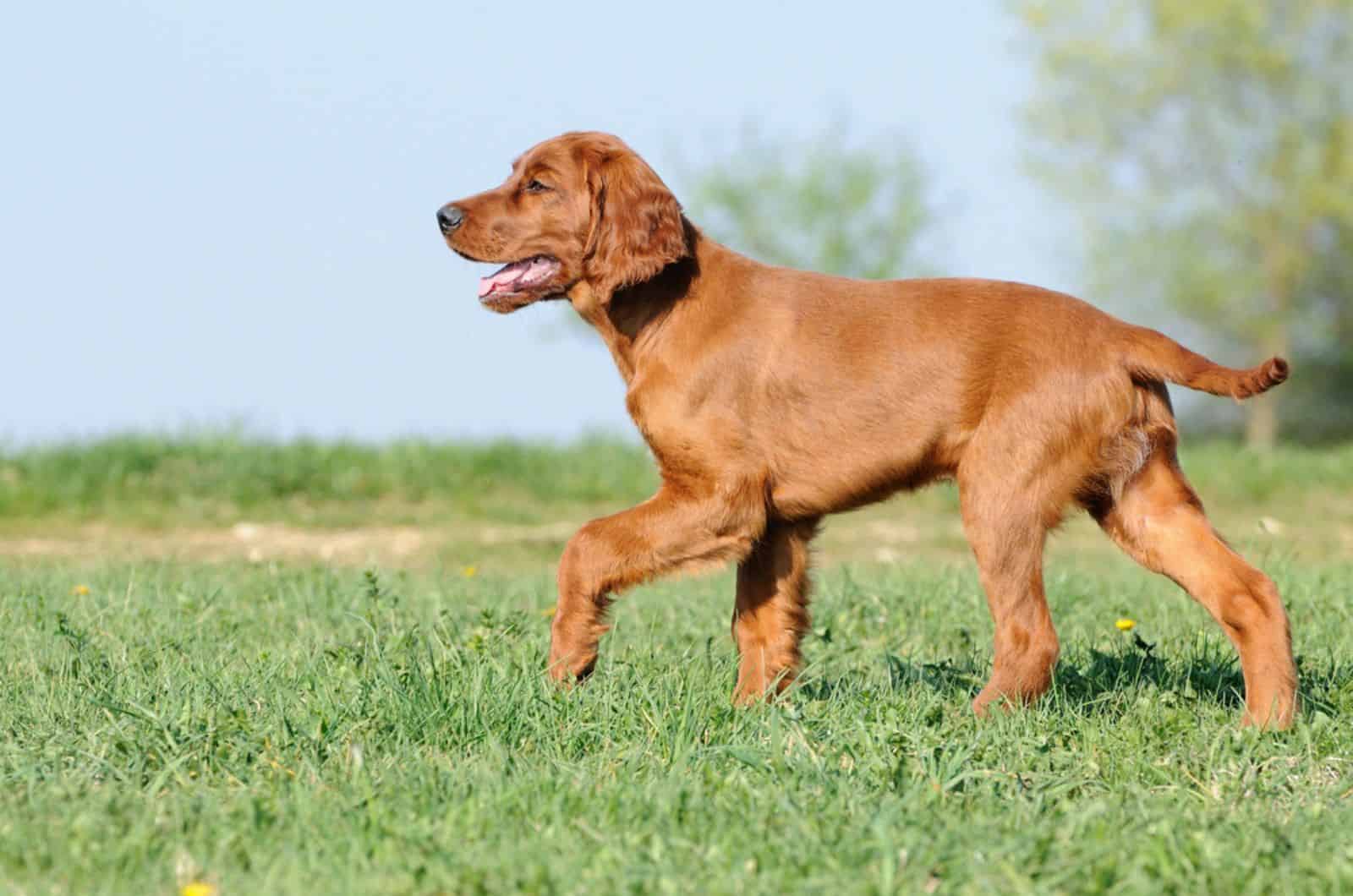
Some puppies will grow to be larger than others, while others will be relatively smaller.
There are many underlying causes, and they can be challenging to separate from one another. The fact that some of those elements are more significant than others is true, but it still doesn’t provide a definitive answer.
With all those caveats in mind, let’s describe some of the most important factors, some of them internal and others external, that help shape the height and weight of an Irish Setter.
Genetics
The primary determinant of your Irish Setter’s size is genetics. A smart technique to estimate your dog’s adult size is to consider how big the dog’s parents are.
In general, there is a good possibility that the puppies will be large if the Irish Setter parents were themselves larger dogs. However, the puppies would probably be a little bit smaller if the parents were a smaller variant.
There aren’t any distinct size categories of the Irish Setter breed, but some of them can be visibly smaller or bigger than others.
It’s an excellent general rule to have even though there are certainly no guarantees and it’s probable that there will be exceptions. Irish Setters are purebred dogs, which makes it a bit simpler to estimate their size than it is for puppies of mixed breeds.
Gender
The size of your dog will also depend on whether it is a male or female because female Setters often have shorter statures than male Setters do.
When puppies are small, the size difference won’t be apparent, but as they become older, it will become visible.
For instance, once your female Setter becomes pregnant and gives birth to puppies, her weight will change significantly.
Furthermore, getting your male Irish Setter neutered could alter his appetite and weight, and the rehabilitation process afterward could also have an impact.
On average, adult male Irish Setters typically weigh 70 pounds and are 27 inches tall at the shoulder, while female Irish Setters are 25 inches and weigh 60 pounds.
Diet
Dog owners frequently worry about their dog’s nutrition and how that may impact its development. Unless a dog has been severely mistreated or undernourished, nutrition usually has minimal impact on a dog’s size.
The exception is that older dogs who are overfed may have joint problems.
When pressure is applied to developing joints, they frequently fail to mature as they should have. As a result, the dog can end up being shorter and under more strain.
All that is to say that you shouldn’t lose too much sleep worrying about whether your choice of diet will negatively affect your pup’s growth. As long as you stick to some basic guidelines when it comes to food quality and quantity, you should be fine.
Exercise
Although you might not think so at first, exercise can have an impact on growth. Young dogs who are overworked sometimes don’t have the capacity to develop into the large dogs they could be.
Dogs who receive insufficient exercise and are permitted to put on too much weight may also become stunted. A sick dog will typically experience growth problems as a result of a medical issue.
Make it a habit of frequently walking your dog and creating an exercise routine for it. Both of you will get used to it quickly and it will have nothing but positive consequences.
Relationship Between Growth And Health In An Irish Setter
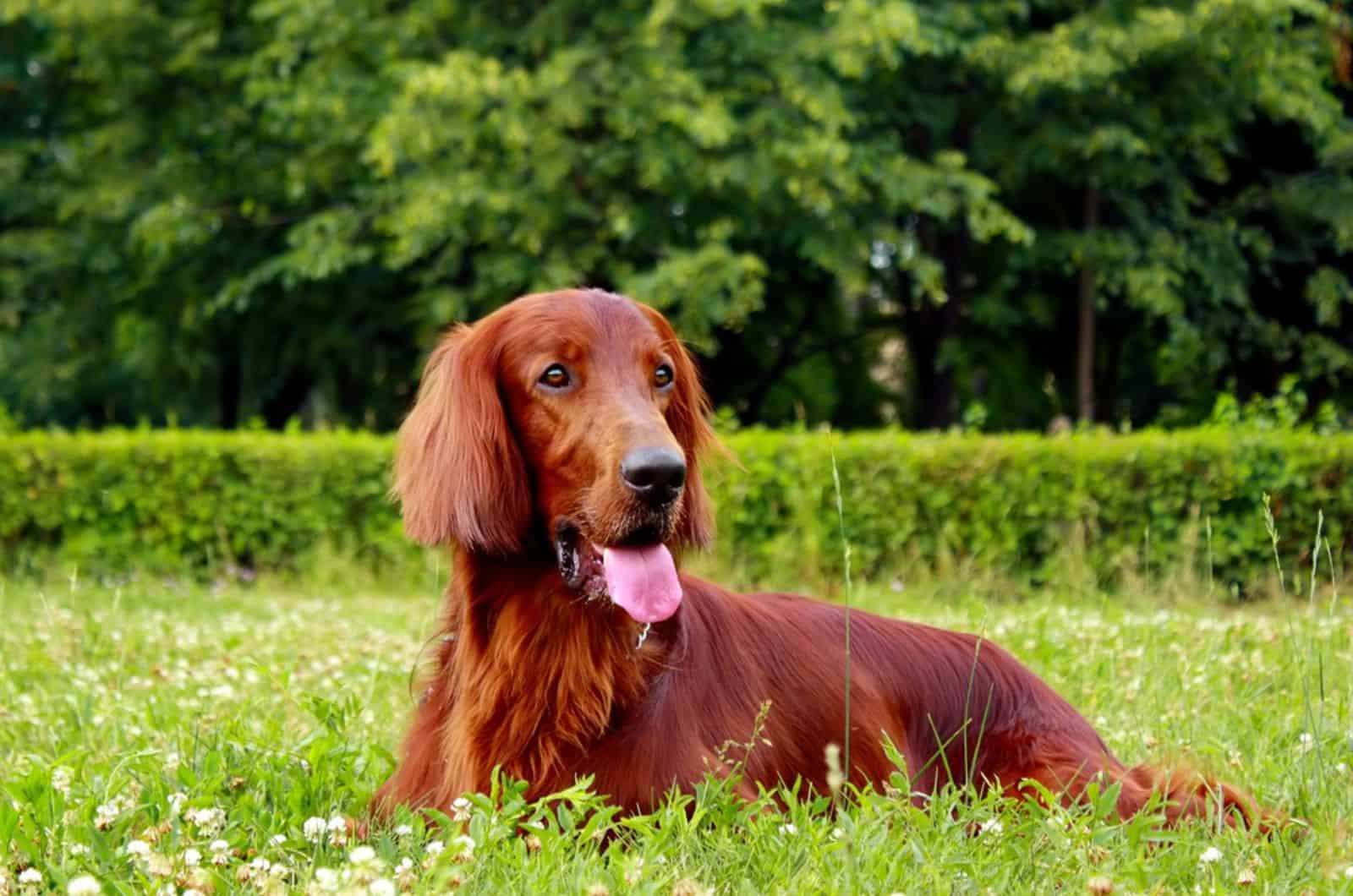
Because purebreds have been developed in a way to protect the bloodline, all purebred dogs run the danger of developing a chronic health condition at some point.
There are a number of congenital medical illnesses that can impair a dog’s growth, but there are also other health issues that emerge gradually over the course of a dog’s life and in some way limit or impede the animal’s ability to grow.
Below are some examples of health problems that may affect the Irish Setter breed of dog.
Hip Dysplasia
Due to improper hip development, your dog’s mobility will be impacted by this common joint condition.
Dogs who have hip dysplasia typically develop it while they are still growing. It causes the hip joint to loosen, which leads to dysfunction and discomfort.
The hip’s bone and cartilage start to deteriorate as the dog grows. This eventually results in arthritis, muscular atrophy, and decreased mobility.
Large-breed dogs are more frequently affected, and research indicates that it is inherited.
Eye Issues
Unfortunately, Irish Setters are quite prone to developing various eye problems, some of which are more serious than others.
While these are generally not directly related to physical growth, they can cause the dog to have a lot of pain and impair its ability to successfully move around. It can also take a mental toll and affect appetite.
You can see how this could lead to underdevelopment.
If you notice any symptoms, such as redness in your dog’s eyes or even a slight vision impairment, contact your vet immediately and see what the best course of action is.
Thyroid Problems
Irish Setter dogs that overproduce thyroid hormone might show symptoms of hyperthyroidism such as diarrhea, fast heartbeat, anxiety, and hyperactivity.
The most prevalent thyroid condition in dogs, however, is hypothyroidism, which results from insufficient thyroid hormone production.
Every organ system in a dog suffering from hypothyroidism is affected, including the digestive, neurological, circulatory, and reproductive systems.
To promote overall thyroid health, a dog with hypothyroidism must receive the right nutrients.
Consult your vet and ask them for any dietary recommendations they might have.
Osteochondritis Dissecans
This orthopedic disorder, which is brought on by abnormal cartilage formation in the joints, typically affects the elbows but has also been observed in the shoulders.
The dog’s elbow becomes painfully stiffened to the point of being unable to bend. As young as four to nine months old, dogs can already show signs of the condition.
High-protein diets or overfeeding with “growth formula” puppy food may hasten its development.
Canine Leukocyte
A hereditary defect called canine leukocyte adhesion deficiency reduces the capacity of white blood cells to fight illness.
Irish Setters are susceptible to this immune-suppressing illness. Dogs with this condition will experience recurrent infections and immunological problems.
A DNA test can be performed to demonstrate that a dog is devoid of the Canine Leukocyte gene, which breeders are now working to eradicate from their breeding lines.
Epilepsy
Epilepsy is a condition that can affect the Irish Setter and result in either moderate or severe seizures.
Epilepsy can be inherited, brought on by metabolic issues, brain-damaging viral diseases, tumors, exposure to toxins, severe head trauma, or it can have an unidentified source.
Unusual behavior, such as frenzied running as if being pursued, stumbling, or hiding, can be a sign of seizures. While watching a seizure can be terrifying, dogs with idiopathic epilepsy typically have a fairly excellent long-term outlook.
Medication can control epilepsy, but it cannot be cured and it sometimes might lead to you having to put down your dog.
However, with the right treatment, an epileptic dog can live a full and healthy life.
Bloat
Large, deep-chested dogs are more likely to develop this potentially fatal illness if they eat quickly, drink a lot of water quickly, or engage in vigorous activity right after a meal.
Bloat happens when the stomach twists after becoming inflated with gas or air. The dog can’t belch or vomit to get rid of the extra air in its stomach, which restricts blood flow to the heart.
The dog has a dip in blood pressure and shock. The dog could die if not given timely medical care. If your dog’s tummy appears enlarged, drools excessively, and retches without vomiting, suspect bloat.
He might also be agitated, melancholy, listless, feeble, and have a fast heartbeat.
What If My Irish Setter Is Having Weight Issues?
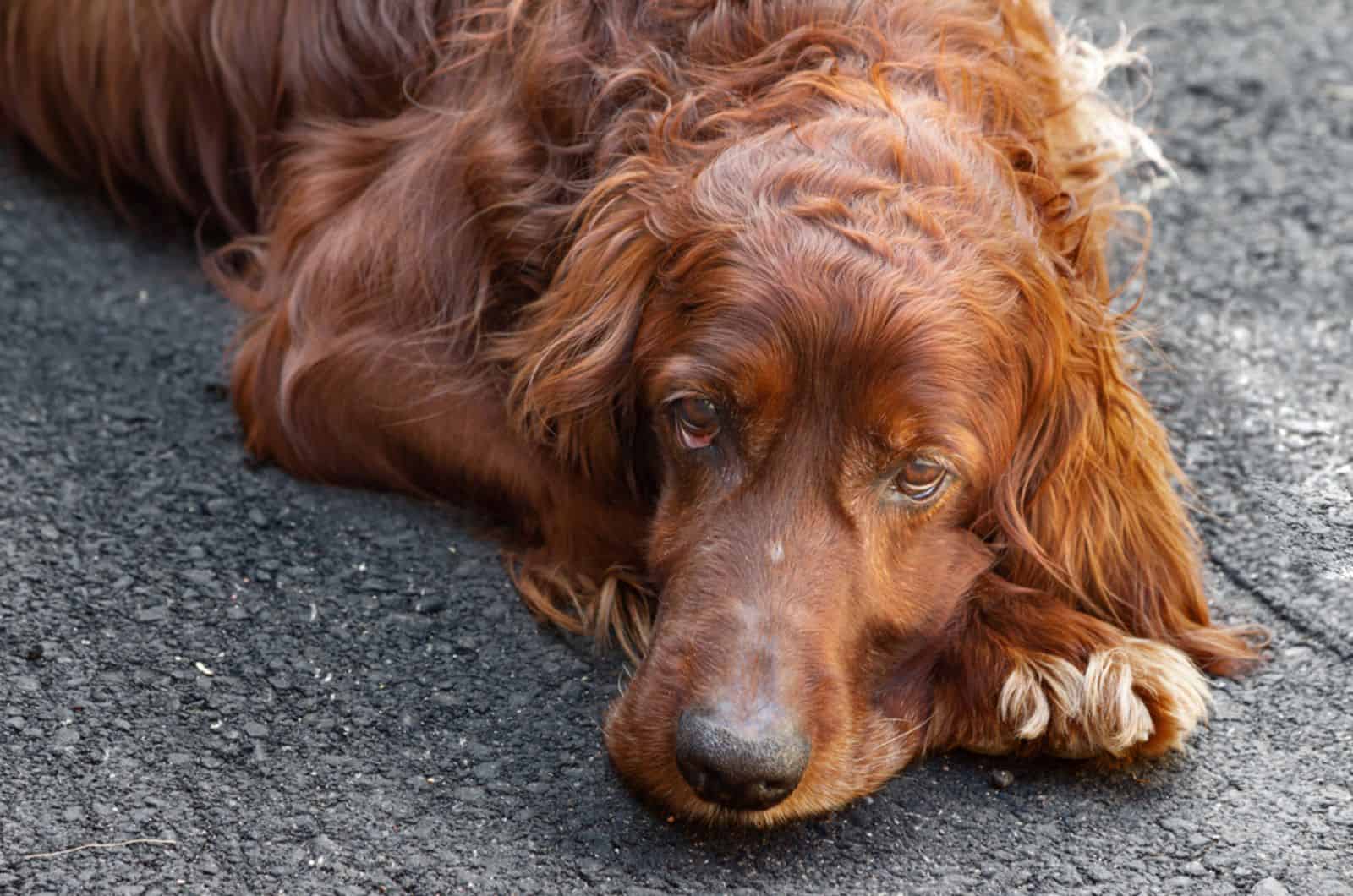
It’s normal to feel anxious if you compare your dog’s size to the Irish Setter growth chart and notice a significant difference.
But you shouldn’t panic. There are numerous explanations as to why a dog’s weight may differ from what is shown on a growth chart.
The values in the chart are averages, and not every dog will match them exactly. In fact, it is absolutely normal to expect that most dogs will be a few pounds over or under.
The term “average” simply denotes the most prevalent size or the midpoint between all other sizes.
The most crucial aspect of keeping an eye on your dog’s growth is making sure it stays on its own growth curve.
There shouldn’t be any cause for concern as long as it is developing steadily and consistently. It’s time to call your veterinarian if your dog has deviated from his normal growth pattern.
Dealing With An Overweight Irish Setter
Speaking of deviations, one of the more common weight-related problems in dogs is obesity and being overweight. If you end up at a point where your Irish Setter weighs noticeably more than it should, you ought to start taking some steps to reduce its weight.
Provide Plenty Of Physical Activity
Exercise is essential for your overweight dog’s health, just like it is for humans. Increased activity aids in your dog’s energy burn-off.
Running marathons or taking your pet on long hikes are not necessary forms of exercise. Regular walks and the chance to play and run without a leash are enough to have a positive long-term impact if you stick to them.
Even providing your dog with an engaging indoor environment that motivates frequent exercise might be beneficial.
Remember that different dog breeds require different amounts of exercise, so for advice on suggested activity levels, check with your dog’s breed standard, breeder, or veterinarian.
Don’t Give In To Puppy Eyes
Begging is sometimes done to get attention and is not always done out of a desire for more food. By praising the behavior, you reinforce it and make it more likely that it will persist.
Just because your Setter is begging doesn’t mean it’s actually hungry, so do your best to stick to a regular feeding schedule and don’t let those adorable little eyes persuade you.
Avoid Table Scraps
Many of us give our dogs too many treats and table scraps, even when they are not begging.
As you would candy for kids, think of snacks and scraps for your pet as a means to help you control them. If you’re going to reward your dog with snacks while you train it, pick ones that are low in calories and fat, and keep the portions minimal.
Use Alternative Rewards
Instead of using treats as a reward for successful training, remember that clickers are great for reinforcement—and they include no calories!
After all, dogs are much smaller than people and even a few additional pounds can have a big impact on their lives. So, concentrate on providing a balanced meal and avoid the need to “reward” them with extras.
Create An Individualized Diet
Every single dog is a unique individual, and when you combine that with the fact that there are a lot of different dog food brands and types out there, you will realize the number of options that you have.
Therefore, it’s important to customize your dog’s nutrition plan to meet its specific requirements. Whether your dog has special requirements for weight management, nutritional sensitivity, or medical care, pick a brand that can meet those demands.
Related: How Much Raw Food To Feed A Puppy
Irish Setter Growth Chart FAQ
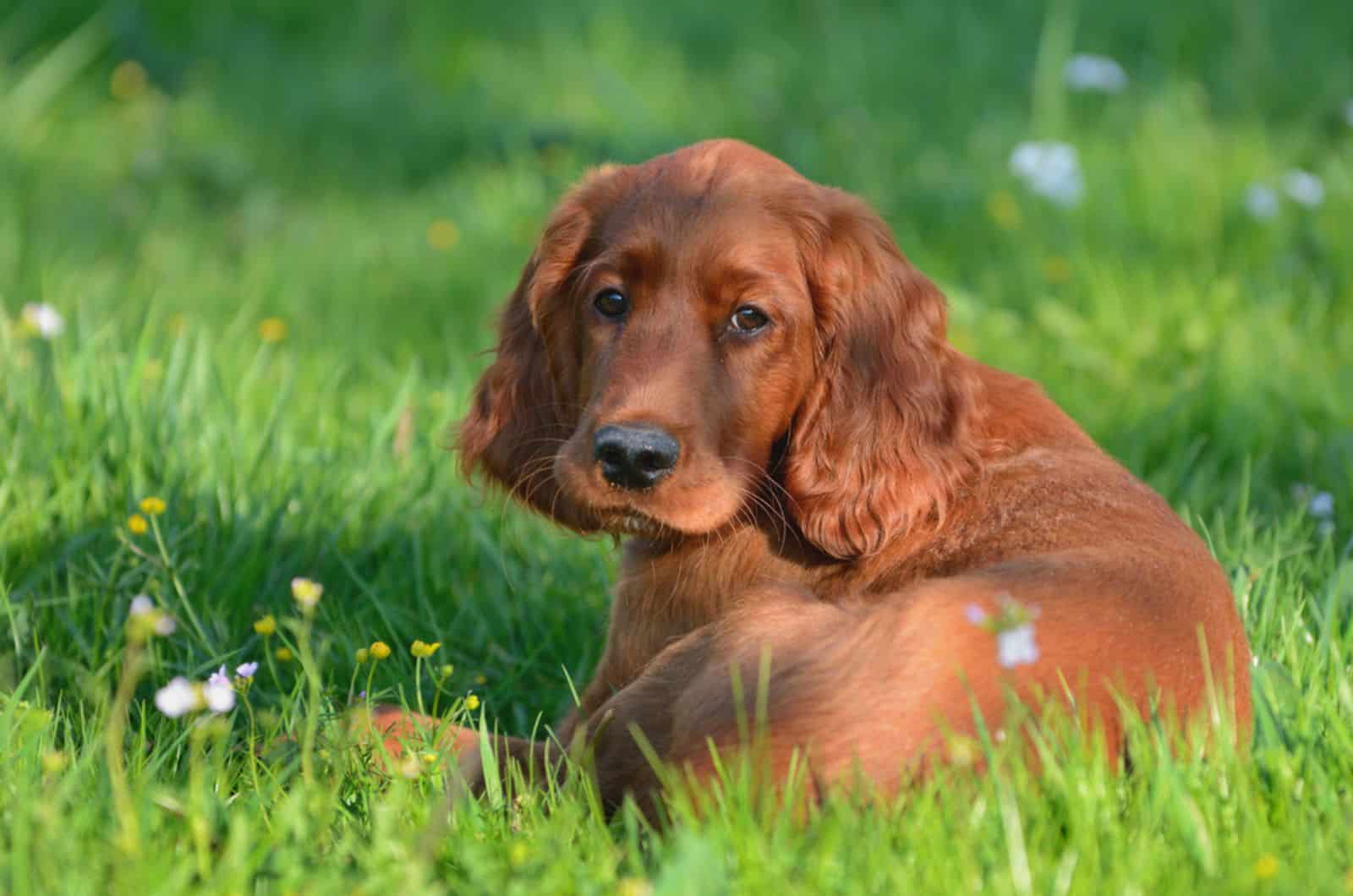
The weight charts above show the average weight of an Irish Setter each month, but your dog may grow at a faster or slower rate. Each puppy develops at its own rate and has a unique personality.
If you’re concerned about the size of your pet, ask your vet for advice.
We can get into a little more detail now that the statistics and facts are out of the way, so let us respond to some of the most frequently asked questions regarding the growth of Irish Setters.
Given their size, Irish Setters can be a challenge, so it’s important to provide them with everything they require to thrive.
Using our Irish Settergrowth chart as a form of weight tracker, you can keep an eye on your puppy’s development and ensure that its weight is increasing appropriately.
Not to mention all the other aspects that need your attention, such as the diet, degree of exercise, training, etc. You can plan your Irish Setter’s nutrition and living arrangements by knowing how big and how heavy it should be at a specific age.
The size chart will, in the broadest sense, assist you in ensuring that your Setter doesn’t become overweight or underweight.
To help you have a decent estimate of how big your puppy will get, you can perform a few different things.
Aside from looking at our Irish Setter growth chart, you can get a great idea of the future size of your pup if you know what the dog’s parents look like.
To get a sense, you can also examine your puppy’s paws. If your puppy’s paws seem oversized when compared ot the rest of its body, it usually means that it will continue growing. Puppies typically have to grow into their paws.
A DNA test can also be used to determine the size of your pup and establish the genetic background of the dog.
Speaking in general terms, male Irish Setters are normally 27 inches tall at the withers, weigh 70 pounds, whereas female Irish Setters are 25 inches and weigh an average of 60 pounds.
That is just about bigger than your average Golden Retriever.
There are slight differences between each individual dog, but they are not so big that there isn’t a clear pattern.
Large dog breeds grow differently from small dogs.
For instance, a toy dog such as a Chihuahua will likely reach its final weight at roughly six months of age, while your Irish Setter will continue growing for much longer than that.
The majority of Irish Setters will keep growing until they are about 18 months old. Some puppies attain their full size by the time they are 12 months old, but some gain weight for an additional 12 months.
It is also possible for them to gain weight after they turn two, but those cases are very rare.
The size of your dog will depend on whether it is a male or a female. The size difference won’t be seen when puppies are little, but as they become bigger, it will be clear.
For instance, your female Setter’s weight will substantially vary after she becomes pregnant and gives birth to puppies.
Male Irish Setters are normally 27 inches tall at the shoulder, weigh 70 pounds, and weigh an average of, whereas female Irish Setters are 25 inches and 60 pounds.
Of course, there are disagreements among dog owners about the optimal time to neuter canines and whether it should even be done at all. To choose the best course of action for both you and your pet, you should always speak with your veterinarian.
If you decide to neuter your male Irish Setter, the optimum time to do so is generally between the ages of nine and twelve months, which is after their adolescent stage.
If you do it earlier, you risk cutting off the flow of the hormone testosterone, which is essential for the development of bones and muscles.
After the female Irish Setter has had her first heat cycle is when it is advised to spay her.
Conclusion
With the help of this Irish Setter growth chart, you can monitor your dog’s growth and make sure that it is developing normally by routinely noting its height and weight.
Irish Setters make fantastic companions, but when you first bring one home, it may seem as though your dog will never stop getting bigger.
Our Irish Setter growth chart will help you predict when that will happen so that you can prepare in time. It will also give you an idea of where your dog should be in terms of weight and size by knowing what the averages are.
